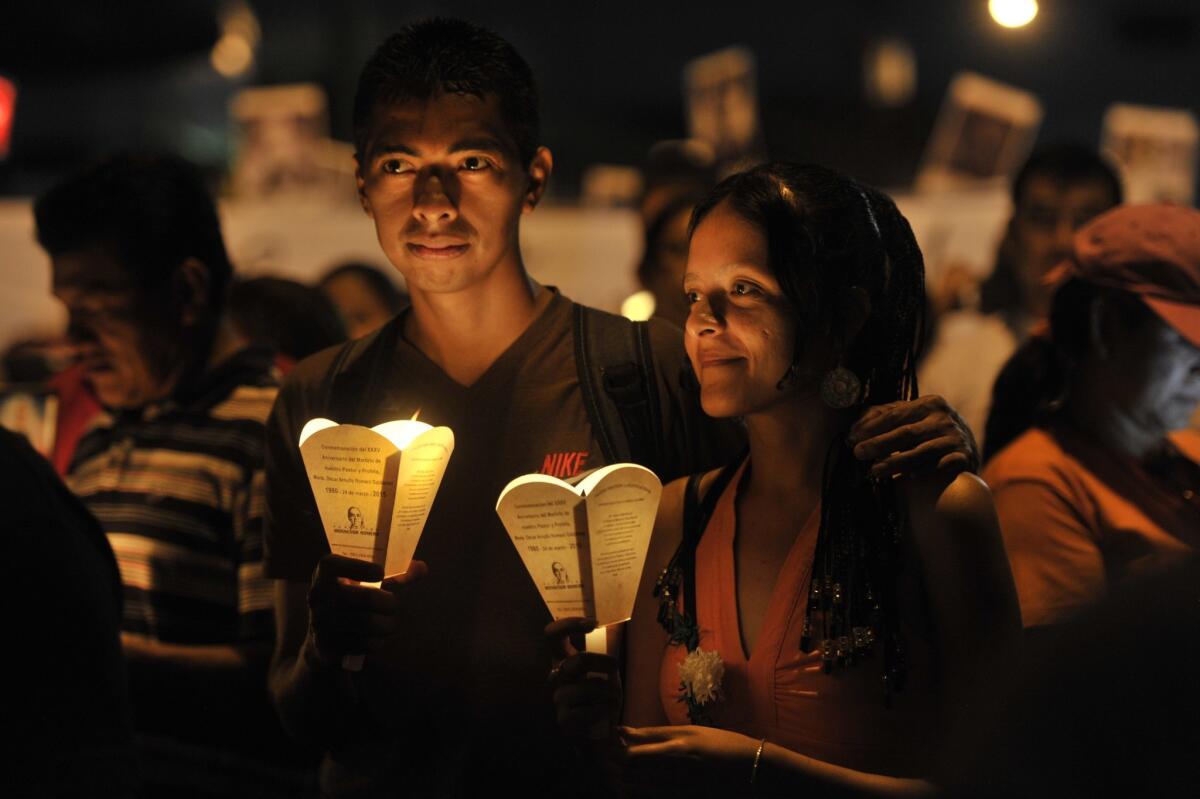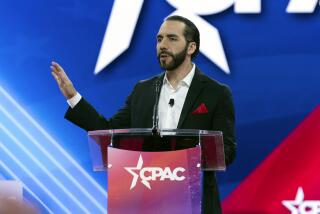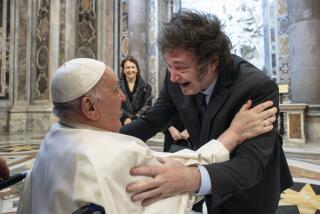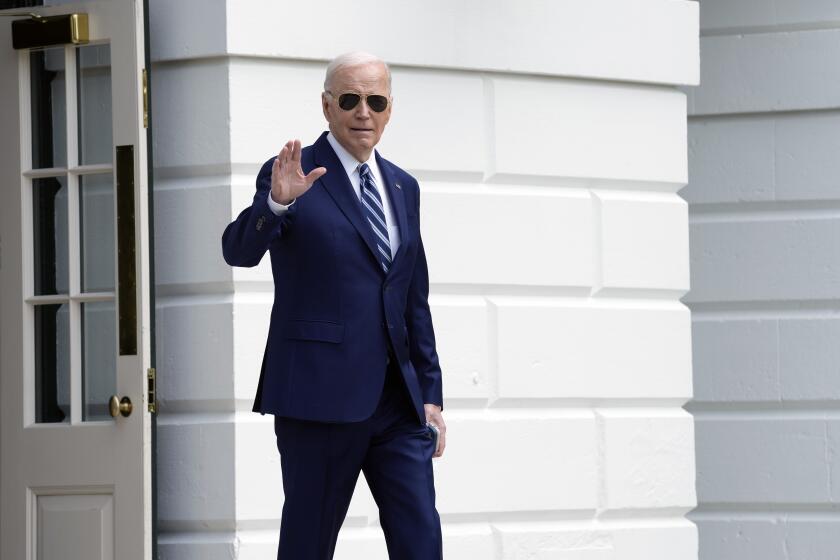Honoring ‘Saint Romero’ is overdue for many Salvadorans

Blanca Estela Garcia did not need the Vatican to tell her that slain Salvadoran Archbishop Oscar Romero was a saint.
Nor did the thousands of people gathering here in parks, in Masses and on marches to the San Salvador Cathedral in recent days to remember Romero’s slaying 35 years ago.
Not the people wearing the “Saint Romero of America” T-shirts or the Romero headbands, key chains and tote bags.
“For us he was our pastor and our guide,” said Garcia, 45, who sews clothes in a maquiladora factory and who wore quotes from Romero’s penultimate sermon on the back of her shirt. “It took a long time for this to happen, but God wanted justice.”
After years of debate over whether Romero was a Communist or a liberation theologian, killed for his politics or for his faith, Pope Francis in February swept aside the doubts, declared him a martyr and announced he would be beatified, the step before sainthood.
The beatification ceremony is scheduled for May 23 in San Salvador. A million people are expected to attend from all over Latin America, where Romero has long been revered as an icon.
Romero’s killing on March 24, 1980, was in many ways the start of El Salvador’s civil war. He became a symbol for the struggle in the country and other parts of Latin America between an impoverished population that leftist guerrillas said they were fighting to uplift and a U.S.-backed, anti-Communist right wing that battled to preserve the status quo.
Conservative Salvadoran governments and Latin American cardinals for years lobbied against Vatican recognition of Romero, who was shot by a sniper as he said Mass in the tiny Divine Providence chapel attached to his living quarters.
Initially a rather conservative cleric, Romero came to advocate on behalf of El Salvador’s poor after witnessing the often deadly government and military brutality against peasants. A colleague, Jesuit priest Rutilio Grande, who worked closely with the poor and was sympathetic to the rebels, was killed by the military in 1977, another milestone in Romero’s growing opposition to the government.
“He would listen to people, he would talk to and visit people even in the most remote communities … at a time of conflict. He’d comfort and exhort,” recalled Sister Noemi Ortiz, who worked with Romero. “Our experience with Monsignor Romero was to experience God on the ground.”
His final homilies were critical of abuses by the left but were increasingly outspoken against the military, even calling on soldiers, in one of his last sermons, to disobey orders that required them to repress the population.
The Vatican endorsement of Romero has made for some awkward moments for the Salvadoran right, still powerful despite the rise of the left to the presidential office in 2009. Members of the right were considered responsible for Romero’s slaying, but conservatives are generally devoutly Roman Catholic and now must consider the Vatican’s ruling.
Romero “belongs to all Salvadorans,” right-wing mayoral candidate Edwin Zamora said during his campaign last month, promising to erect a memorial to the slain cleric if he won. He was assailed by the left for what was seen as cheap electioneering tactics.
Other key figures on the right have remained largely quiet.
A truth commission after the war formally ended in 1992 held that army Maj. Roberto D’Aubuisson, who died that same year, was responsible for ordering Romero’s killing. D’Aubuisson was the founder of the ultraconservative Arena political party, which ruled El Salvador for two decades until 2009, when the Farabundo Marti National Liberation Front, the party of former leftist guerrillas, won the presidency.
Discussion of Romero’s killing now raises uncomfortable, unanswered questions about who above D’Aubuisson sanctioned such a potentially controversial slaying. Many here believe members of the country’s business elite, some of whom are still in entrepreneurial positions of power, were responsible.
More than 20 years after the war ended, El Salvador remains a haunted, politically divided place. Some advances have been made in reconciliation, but political polarization remains, compounded by newer problems such as gang warfare and drug trafficking.
Today’s El Salvador is reflected by the fact that there is a golden statue erected in Romero’s honor in the prominent Savior of the World plaza in downtown San Salvador, something that would have been unthinkable in the 1990s. But today’s El Salvador is also reflected by the fact that vandals recent broke off the arm of the Romero statue. Authorities scurried to repair it in time for the current ceremonies.
At one of the events, several thousand people came together around the Romero statue Saturday evening, singing Christian folk songs, dancing under enormous portraits of Romero and then carrying candles as they marched about three miles to the cathedral.
Many in the crowd were far too youthful to have known the bishop. Yet they knew of him, from their grandparents’ stories or lessons in church or school.
“He is already a saint for us,” said Jorge Jimenez, 13, wearing a “Saint Romero” T-shirt and a baseball cap decorated with a hammer and sickle.
Gregorio Rosa Chavez, auxiliary bishop of San Salvador and a Romero protege, remarked on the large number of youth. “There is a new dynamism surrounding Monsignor Romero, you see it here in the multitude, in the young people,” he said.
Rosa Chavez waded through the crowd in his white robes, pausing to shake hands, hug the faithful or pose for pictures. There were musical groups, American and European pilgrims, even nuns from Angola.
Groups shouted: “Long live El Salvador!” “Long live the church!” “Long live Saint Romero!”
Follow @TracyKWilkinson on Twitter for news out of Latin America
More to Read
Start your day right
Sign up for Essential California for news, features and recommendations from the L.A. Times and beyond in your inbox six days a week.
You may occasionally receive promotional content from the Los Angeles Times.







